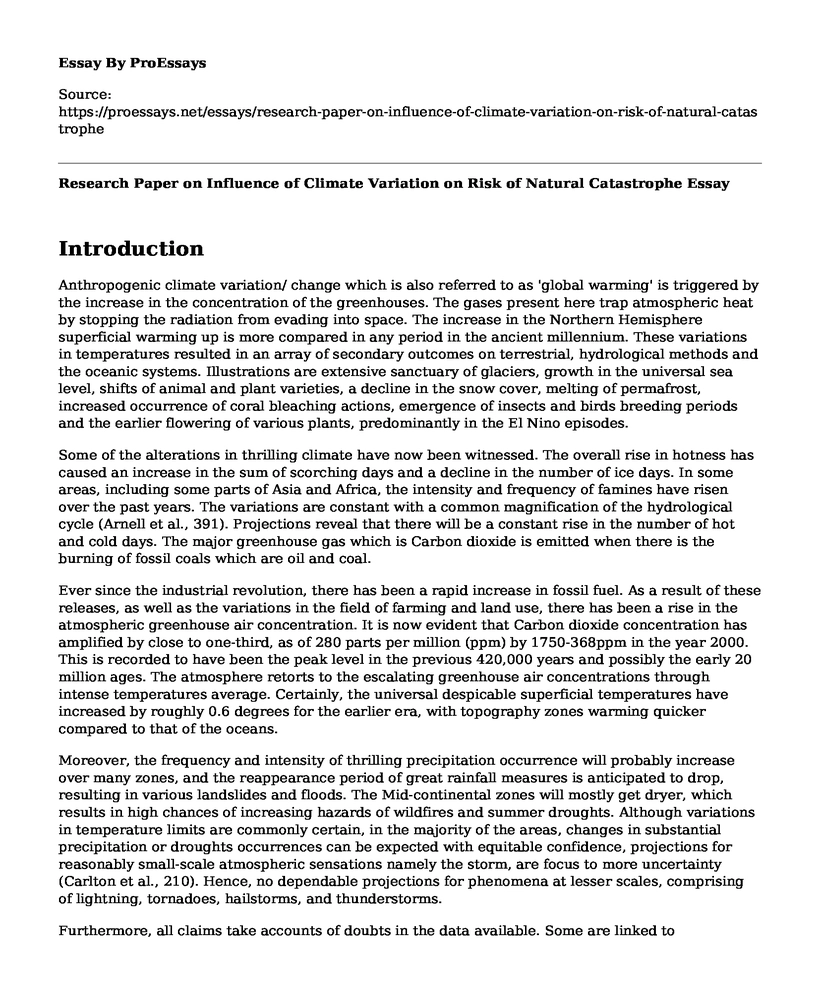Introduction
Anthropogenic climate variation/ change which is also referred to as 'global warming' is triggered by the increase in the concentration of the greenhouses. The gases present here trap atmospheric heat by stopping the radiation from evading into space. The increase in the Northern Hemisphere superficial warming up is more compared in any period in the ancient millennium. These variations in temperatures resulted in an array of secondary outcomes on terrestrial, hydrological methods and the oceanic systems. Illustrations are extensive sanctuary of glaciers, growth in the universal sea level, shifts of animal and plant varieties, a decline in the snow cover, melting of permafrost, increased occurrence of coral bleaching actions, emergence of insects and birds breeding periods and the earlier flowering of various plants, predominantly in the El Nino episodes.
Some of the alterations in thrilling climate have now been witnessed. The overall rise in hotness has caused an increase in the sum of scorching days and a decline in the number of ice days. In some areas, including some parts of Asia and Africa, the intensity and frequency of famines have risen over the past years. The variations are constant with a common magnification of the hydrological cycle (Arnell et al., 391). Projections reveal that there will be a constant rise in the number of hot and cold days. The major greenhouse gas which is Carbon dioxide is emitted when there is the burning of fossil coals which are oil and coal.
Ever since the industrial revolution, there has been a rapid increase in fossil fuel. As a result of these releases, as well as the variations in the field of farming and land use, there has been a rise in the atmospheric greenhouse air concentration. It is now evident that Carbon dioxide concentration has amplified by close to one-third, as of 280 parts per million (ppm) by 1750-368ppm in the year 2000. This is recorded to have been the peak level in the previous 420,000 years and possibly the early 20 million ages. The atmosphere retorts to the escalating greenhouse air concentrations through intense temperatures average. Certainly, the universal despicable superficial temperatures have increased by roughly 0.6 degrees for the earlier era, with topography zones warming quicker compared to that of the oceans.
Moreover, the frequency and intensity of thrilling precipitation occurrence will probably increase over many zones, and the reappearance period of great rainfall measures is anticipated to drop, resulting in various landslides and floods. The Mid-continental zones will mostly get dryer, which results in high chances of increasing hazards of wildfires and summer droughts. Although variations in temperature limits are commonly certain, in the majority of the areas, changes in substantial precipitation or droughts occurrences can be expected with equitable confidence, projections for reasonably small-scale atmospheric sensations namely the storm, are focus to more uncertainty (Carlton et al., 210). Hence, no dependable projections for phenomena at lesser scales, comprising of lightning, tornadoes, hailstorms, and thunderstorms.
Furthermore, all claims take accounts of doubts in the data available. Some are linked to uncertainties of the climate theory and forthcoming emissions, others to inadequate regular information verifying the model while others downscaling to local measure. As with the weather phenomena, the influence of these variations will rely on the mechanisms in their occurrences. In some regions, global warming boosts agricultural production (Lesk et al,). In many zones, it also reduces the demand for heating energy in the winter. Nevertheless, as climate variations continue, the influence of the balances becomes further negative, and there will be also further irreversible effects, such as the damage of the ecosystems. It is dependable on the abilities to familiarize to the variations in humans.
Conclusion
In conclusion, variations in infrastructure designs, changes in produces as well increases the advantages of climate change. Ability to familiarize to the climatic changes is regarded to be greater in the developed compared to the developing countries.
Works Cited
Arnell, Nigel W., and Simon N. Gosling. "The impacts of climate change on river flood risk at the global scale." Climatic Change 134.3 (2016): 387-401.
Carlton, J. Stuart, et al. "The effects of extreme drought on climate change beliefs, risk perceptions, and adaptation attitudes." Climatic Change 135.2 (2016): 211-226.
Lesk, Corey, Pedram Rowhani, and Navin Ramankutty. "Influence of extreme weather disasters on global crop production." Nature 529.7584 (2016): 84.
Cite this page
Research Paper on Influence of Climate Variation on Risk of Natural Catastrophe. (2022, Mar 16). Retrieved from https://proessays.net/essays/research-paper-on-influence-of-climate-variation-on-risk-of-natural-catastrophe
If you are the original author of this essay and no longer wish to have it published on the ProEssays website, please click below to request its removal:
- Why Should Human Beings Protect the Environment? - Essay Sample
- Why Should We Make Europe a Wilder Place?
- Essay Example on Love Canal: NY's Environmental Disaster Epicenter
- Essay Sample on Climate Change: Human vs Natural Causes
- Essay Example on Protecting Our Planet: The Need for Sustainability
- Essay Sample on U.S. Waste Production: Why Recycling Matters & How to Do It Better
- Paper Example on Gas or Grouse: Systemic, Corporate & Individual Issues & Ethical Principles







